This article may contain affiliate links. If you make a purchase after clicking on a link we may earn a small commission at no extra cost to you. As an Amazon Associate, I earn from qualifying purchases.
15 Different Types of Trout – (Native, Invasive and Hybrids)
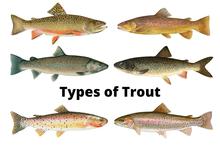
With so many different types of trout it can often be very confusing for the beginner angler.
Even experienced anglers may have difficulty recognizing some of the lesser known trout species.
Trout are freshwater fish species of the genera Oncorhynchus, Salmo, and Salvelinus, all of which belong to the Salmoninae subfamily of the Salmonidae family.
Non-salmon fish with names that incorporate the word trout include Cynoscion nebulosus, spotted seatrout, and speckled trout.
Fun Fact:
Most anglers assume Brown Trout are native but they were actually introduced from Germany in 1883
Types of Trout
- Rainbow Trout
- Brook Trout
- Cutthroat Trout
- Brown Trout
- Lake Trout
- Steelhead
- Tiger Trout
- Dolly Varden Trout
- Splake
- Bull Trout
- Palomino Trout
- Gila Trout
- Golden Trout
- Apache Trout
- Arctic Char
While there are many regional variations of trout we have listed the fifteen most common trout species that you are likely to encounter out in the wild.
Rainbow Trout
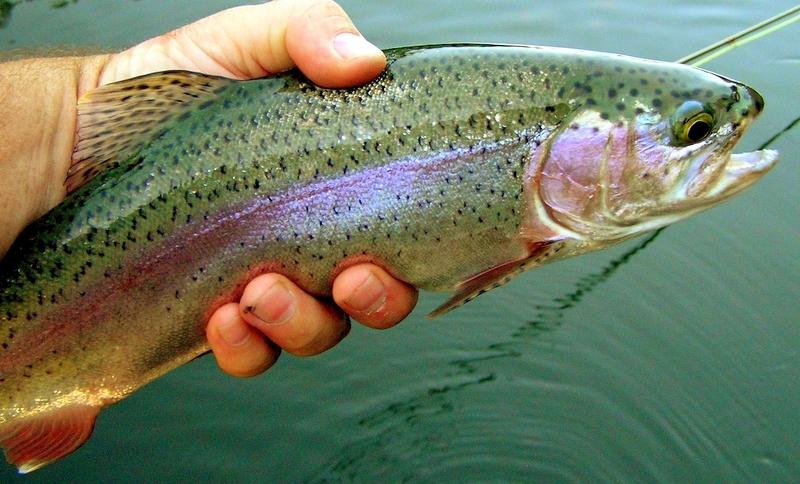
Rainbow trout (Oncorhynchus mykiss) is a salmonid that is found only in cold-water Pacific Ocean rivers in Asia and North America.
Adult rainbow trout weigh between 1 and 5 lb (0.5 and 2.3 kg) in freshwater streams, although lake-dwelling and anadromous species may weigh up to 20 lb (9 kg). Coloration varies widely across subspecies, forms, and environments.
Coloration varies greatly among locations and subspecies. Adult freshwater forms are often blue-green or olive green with strong black spotting along the body.
Adult fish have a broad crimson stripe extending from the gills to the tail, which is particularly noticeable in breeding males.
The caudal fin is squarish with just a few forks. Lake-dwelling and anadromous variants are often silverier in color, with the reddish line nearly totally absent.
Rainbow trout juveniles have parr markings (dark vertical bars) like other salmonid juveniles. Parr markings are frequently preserved in various redband and golden trout varieties until maturity.
Some populations of coastal rainbow trout (O. m. irideus) and Columbia River redband trout (O. m. gairdneri), as well as cutbow hybrids, may have reddish or pink throat markings similar to cutthroat trout.
Fin clips are used in several areas to identify hatchery-bred trout from natural trout. The adipose fin is clipped as a management technique to identify hatchery-reared fish.
Brook Trout
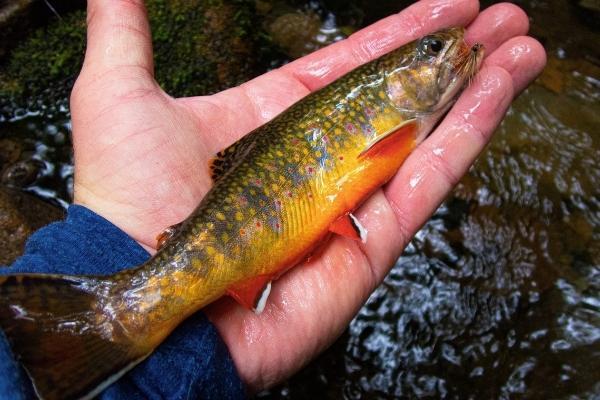
The brook trout (Salvelinus fontinalis) is a freshwater fish species in the Salvelinus genus and the Salmonidae family.
It is indigenous to Eastern North America, including the United States and Canada, but it has been introduced to other regions of the continent, as well as Iceland, Europe, and Asia.
In certain parts of its distribution, it is also known as the eastern brook trout, speckled trout, brook charr, squaretail, brookie, or mud trout.
The brook trout is the state fish of nine states in the United States: Michigan, New Hampshire, New Jersey, New York, North Carolina, Pennsylvania, Vermont, Virginia, and West Virginia, as well as Nova Scotia’s Provincial Fish.
The brook trout is dark green to brown in color, with a distinctive marbled pattern of lighter colours along the flanks and back, extending at least to the dorsal fin and, in some instances, all the way to the tail.
There is a noticeable dispersion of red dots surrounded by blue halos around the sides. The belly and lower fins are red in color, with white leading edges. When the fish are spawning, their bellies become brilliant red or orange, particularly the males.
Cutthroat Trout
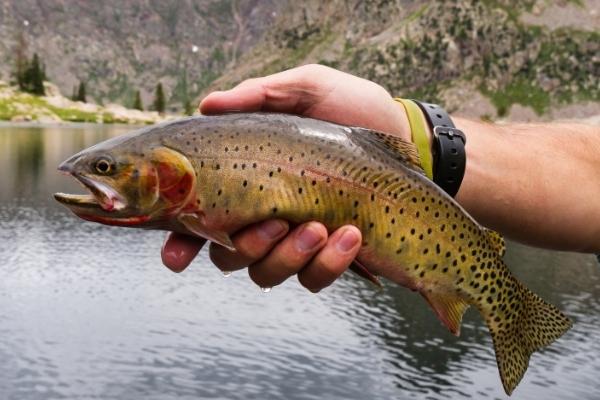
The cutthroat trout (Oncorhynchus clarkii) is a salmonid fish species found only in cold-water rivers in North America’s Pacific Ocean, Rocky Mountains, and Great Basin.
As a member of the genus Oncorhynchus, it is a Pacific trout, which includes the globally distributed rainbow trout. Cutthroat trout are a popular gamefish, especially for fly fishers.
The common name “cutthroat” refers to the conspicuous red color on the lower jaw.
Cutthroat trout tend to live and spawn in small to medium-sized, clean, well-oxygenated, shallow rivers with gravel bottoms. Unlike most trout when spawning the prefer to do so in in clean, cold, and rather deep lakes.
They are native to alluvial or freestone streams that are frequent tributaries of rivers in the Pacific, Great, and Rocky Mountains. Cutthroat trout spawn in the spring and may unintentionally but naturally hybridize with rainbow trout, producing viable cutbows.
Many subspecies of cutthroat trout are now classified as threatened in their natural ranges due to habitat degradation and the invasion of non-native species. Two subspecies, O. c. alvordensis and O. c. macdonaldi, are thought to be extinct.
Cutthroat trout are raised in hatcheries to help restore populations in their natural ranges and to provide non-native lake settings for fishing. Cutthroat trout and several subspecies have been selected as the official state fish of seven western U.S. states.
Brown Trout
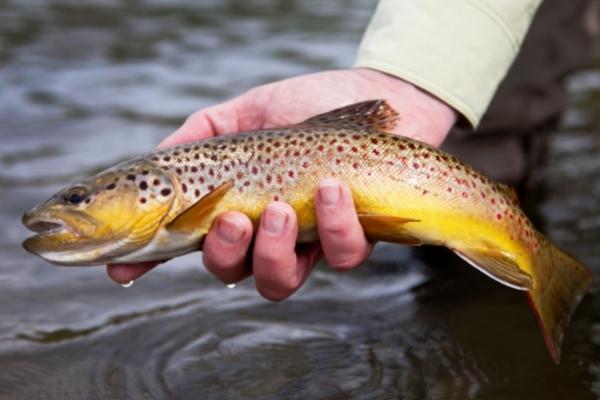
Brown trout (Salmo trutta) is a salmonid fish native to Europe that has been widely introduced into suitable environments across the globe.
Although considered an invasive species of trout in the United States it has been so well accepted as a be considered a true wild trout.
A thin, reddish-brown body with a long, narrow head are distinguishing features.
Freshwater brown trout varies in color from completely silver with few spots and a white belly to the more well-known brassy brown cast with medium-sized spots encircled by lighter halos on the fish’s belly. The more silver forms, the more likely they are to be mistaken for rainbow trout.
The brown trout is a medium-sized fish that may reach a mature weight of 1.0 kilogram (2.2 lb) or less and a length of around 100 cm (39 in) in certain areas. However, in many smaller rivers, a mature weight of 1.0 kg (2.2 lb) or less is usual.
It is made up of entirely freshwater populations known as the riverine ecotype, Salmo trutta morpha fario, a lacustrine ecotype known as lake trout, and anadromous forms known as sea trout, S. trutta morpha trutta.
The latter spends the most of its life in the sea, only returning to fresh water to spawn.
Sea trout are known by a number of names in Ireland and the United Kingdom, including sewin in Wales, finnock in Scotland, peal in the West Country, mort in North West England, and white trout in Ireland.
Lake Trout
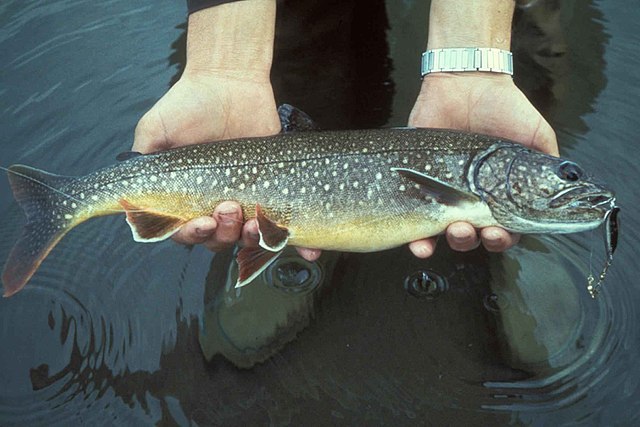
Lake trout (Salvelinus namaycush) is a freshwater char that mostly inhabits lakes in northern North America. Other names for it include mackinaw, namaycush, lake char (or charr), touladi, togue, and grey trout.
In Lake Superior, it is also known as siscowet, paperbelly, and lean. Lake trout is prized as a game fish as well as a food species. Those caught with dark coloration are known as mud chickens.
Lake trout have a rather small range. They can only be found in northern North America, mostly in Canada, but also in Alaska and, to a lesser extent, the northeastern United States.
Lake trout have been widely introduced into non-native streams across North America and many other parts of the world, mostly in Europe, but also in South America and parts of Asia.
Lake trout are the largest of the chars, with a record weight of more than 102 pounds (46 kg) (netted) and a length of 50 inches (130 cm), and fish exceeding 15–40 pounds (6.8–18.1 kg) are common. The standard length ranges from 24 to 36 inches (61 and 91 cm).
According to the IGFA, the largest caught on a rod and reel was 72 pounds (33 kg), taken in Great Bear Lake in 1995 and measuring 59 inches in length (150 cm).
Steelhead
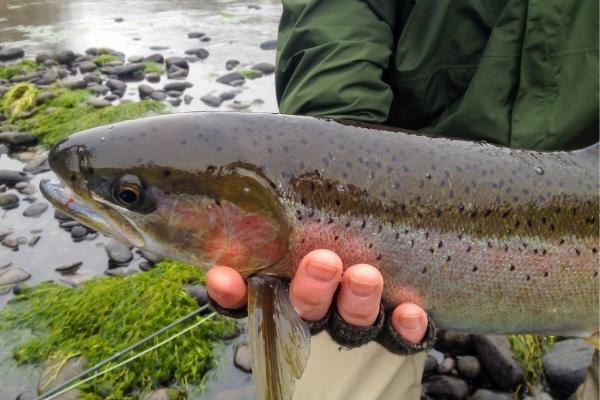
Steelhead, often known as steelhead trout, is the anadromous variant of the coastal rainbow trout (Oncorhynchus m. irideus) or redband trout (O. m. gairdneri) that returns to fresh water to reproduce after spending two to three years in the ocean.
Steelhead are endemic to the Pacific basin’s cold-water streams in Northeast Asia and North America.
Steelhead, like other sea-run trout and salmon, spawn in freshwater, smolts move to the ocean for several years of foraging, and adults return to their natal streams to spawn. Steelhead are iteroparous(breed several times in their life), yet survival rates range from 10 to 20 percent.
Freshwater rainbow trout, often known as steelhead, have been introduced into the Great Lakes and travel into rivers to spawn. Commercially propagated steelhead are known as Ocean Trout in Tasmania.
Tiger Trout
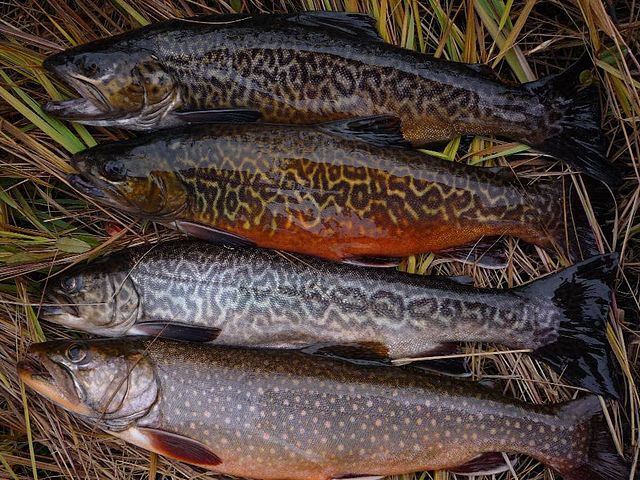
The Tiger trout (Salmo trutta Salvelinus fontinalis) is a sterile intergeneric hybrid of brown and brook trout (Salmo trutta Salvelinus fontinalis) (Salvelinus fontinalis). The term is derived from the strong vermiculations that resemble tiger stripes.
In the wild, the fish is an outlier, with brook trout having 84 chromosomes and brown trout having 80. Records show incidences as far back as 1944. The cross is distinct in that the parents are from different genera.
Tiger trout may be produced on a constant basis in hatcheries. This is performed by fertilizing brown trout eggs with brook trout milt and then shocking them with heat, resulting in the production of an extra set of chromosomes and increasing survival rates from 5% to 85%.
Tiger trout are claimed to develop faster than native species, however this is not widely agreed upon, and they have been introduced for sport fishing on a regular basis.
Dolly Varden Trout
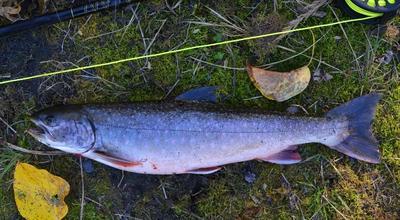
The Dolly Varden trout (Salvelinus malma) is a salmonid fish found only in cold-water rivers of the Pacific Ocean in Asia and North America. It belongs to the genus Salvelinus, which includes 51 species, the most prominent of which are the brook, lake, and bull trout, as well as the Arctic char.
The two subspecies of Dolly Varden found in North America are the Northern Dolly Varden (S. m. malma) of the Arctic drainages and the Southern Dolly Varden (S. m. lordi) of the Pacific drainages. These might potentially be identified as separate mitochondrial lineages.
Splake

The splake (Salvelinus namaycush x Salvelinus fontinalis) is a fish hybrid that was formed by crossing a male brook trout (Salvelinus fontinalis) with a female lake trout (Salvelinus namaycush).
The name is a hybrid of speckled trout (another name for brook trout) and lake trout, and it was perhaps used to designate such hybrids as early as the 1880s.
Male lake trout-female brook trout hybrids (called “brookinaws”) have also been bred, but have not been as successful.
Bull Trout
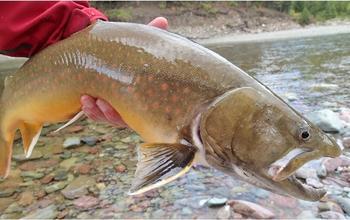
The bull trout (Salvelinus confluentus) is a salmonid char that is only found in northern North America. S. confluentus, formerly known as the “Dolly Varden” (S. malma), was reclassified as a separate species in 1980. Bull trout are listed as an endangered species under the United States Endangered Species Act (1998).
The fins of a bull trout, like those of other char species, have white leading edges. Its name comes from its unusually large head and mouth for a salmonid. Bull trout may grow to reach 103 cm (41 in) long and 14.5 kg in weight (32 lb).
Bull trout may be migratory, moving over vast river systems, lakes, and the ocean, or resident, living their whole lives in the same stream.
Migratory bull trout are much larger than resident bull trout, which seldom exceed more than 2 kg (4.4 lb).
Bull trout are distinguished from brook trout (S. fontinalis) by the absence of noticeable spots on the dorsal fin as well as yellow, orange, or salmon-colored patches on the back, as are red markings with blue halos on the brook trout. The tail fin of a bull trout is not as forked as that of a lake trout.
Tiger trout are claimed to develop faster than native species, however this is not widely agreed upon, and they have been introduced for sport fishing on a regular basis.
Palomino Trout
Golden rainbow trout, often known as palomino trout, are developed from a single mutant color variation of O. mykiss that was discovered in a West Virginia fish hatchery in 1955.
The golden rainbow trout is mostly yellowish, with no usual green field or black dots but a diffuse red stripe.
The palomino trout is a cross between a golden and a common rainbow trout, resulting in a hue that is somewhere in the middle.
The golden rainbow trout is not the same as the naturally occurring O. m. aguabonita, often known as the Kern River golden trout of California.
Gila Trout
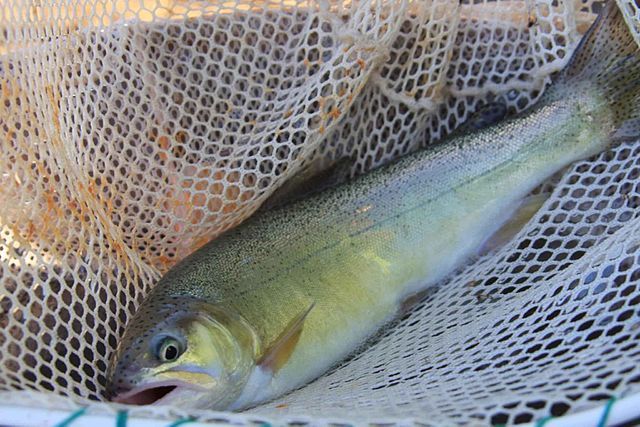
The Gila trout (Oncorhynchus gilae) is a salmonid species endemic to the Southwest United States that is related to the rainbow trout. Prior to 2006, the Gila trout was categorized as endangered by the federal government.
The Gila trout was downlisted to threatened in July 2006, after extensive effort by the Game and Fish departments of New Mexico and Arizona, as well as the US Forest Service and the US Fish and Wildlife Service.
By the time the Gila trout was restricted to fishing in the 1950s, its numbers and range had been decreased and reduced to the point that the copper-colored trout just wasn’t available to fishermen. As of 2011, this fish may be caught in both states.
The Gila trout is endemic to the Gila River’s tributaries in Arizona and New Mexico. The Gila trout has traditionally been found in Arizona’s Verde and Agua Fria drainages.
The body of a Gila trout is yellow with black markings. The average overall length is about 30 cm (11.8 in), while the highest total length is around 55 cm (21.7 in).
Gila trout and Apache trout are closely related. Apache trout, on the other hand, might have a spot behind and in front of the pupil (eye) as well as large visible spots on the body, while Gila trout have several little black spots on the top half of the body.
Golden Trout
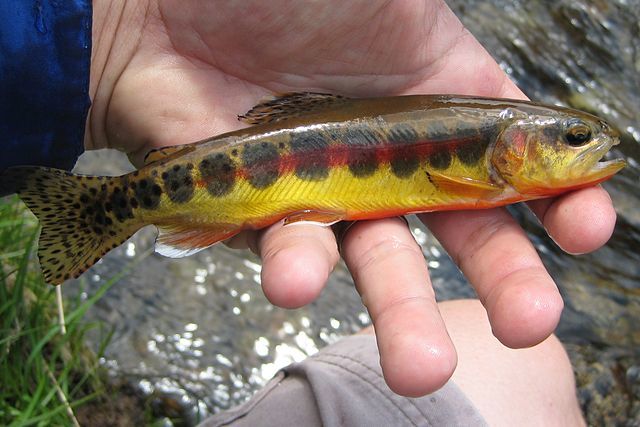
The Golden Trout (Oncorhynchus aguabonita or Oncorhynchus mykiss aguabonita) is a species of trout endemic to California.
The Golden Trout Creek (tributary to the Kern River), Volcano Creek (tributary to the Golden Trout Creek), and the South Fork Kern River are the most common places to find the golden trout. Since 1947, the Golden trout has served as California’s official freshwater state fish.
The California golden trout is connected to two subspecies of rainbow trout. The Little Kern golden trout (O. m. whitei), which lives in the Little Kern River basin, and the Kern River rainbow trout (O. m. gilberti), which lives in the Kern River system. These three fish, when combined, comprise what is known as the “golden trout complex.”
The golden trout was originally characterized as a subspecies of the salmon species, with the name Salmo mykiss aguabonita, and it is still sometimes considered a subspecies (now named Oncorhynchus mykiss aguabonita), along with numerous other rainbow trout subspecies generally known as redband trout.
The golden trout has golden flanks with red horizontal stripes along the lateral lines and around 10 black, vertical, oval markings (called “parr marks”) on each side. The leading margins of the dorsal, lateral, and anal fins are white. Adults in their natural environment are 6 to 12 inches (15 to 30 cm) length. Large fish are those that measure more than 12 inches (30 cm). Golden trout transplanted to lakes have grown to weigh up to 11 pounds (5.0 kg).
The golden rainbow trout, commonly known as the palomino trout, should be differentiated from the similarly called golden rainbow trout. The golden rainbow trout is a rainbow trout color variation.
The golden trout is endemic to California’s southern Sierra Nevada highlands and may be found at altitudes ranging from 6,890 feet (2,100 m) to 10,000 feet (3,000 m). Outside of its native California habitat, Golden trout are more often seen in cirques and rivers in wilderness areas at elevations of 10,500–12,000 feet.
Apache Trout
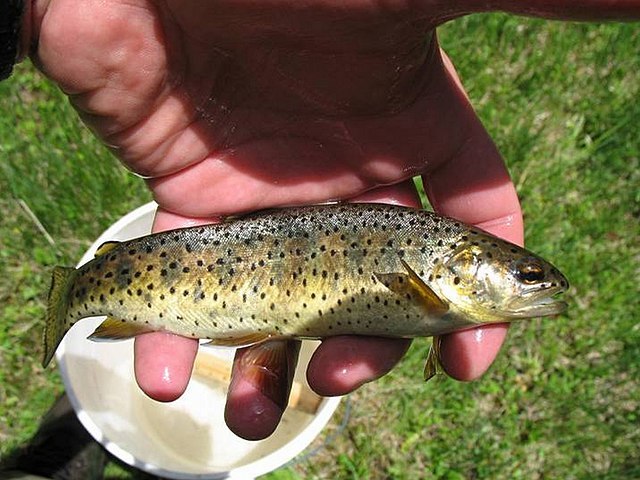
Oncorhynchus apache is a freshwater fish species of the salmon family (family Salmonidae) in the order Salmoniformes. It belongs to the Pacific trout family.
The Apache trout is Arizona’s state fish and one of just two trout species endemic to the state, the other being the gila trout (O. g. gilae).
It is endemic to clean, chilly streams in the White Mountains that run through coniferous woods and marshes, but it has been imported into numerous local lakes.
The Apache trout is found in the upper Salt River basin (Black and White rivers) as well as the upper Little Colorado River watershed. Apache trout have been introduced into isolated streams in the Pinaleno Mountains and the Grand Canyon’s North Rim that are outside of their traditional habitat.
The Apache trout measures 6–24 in (15–61 cm) in length and weighs 0.4–6 lb (0.2–2.7 kg). It seldom surpasses 10 in (25 cm), although in its native, headwater streams, it may grow up to 16 in (40 cm).
Apache trout are yellowish-gold in color with a golden belly and medium-sized black patches that extend beyond the lateral line and onto the dorsal and tail fins.
The top of its head and back are dark olive in color, and two little black spots on each side of the pupil give the illusion of a black stripe/mask through each of its eyes. A neck mark, varying in hue from yellow to gold, may appear below the lower jaw.
Arctic Char
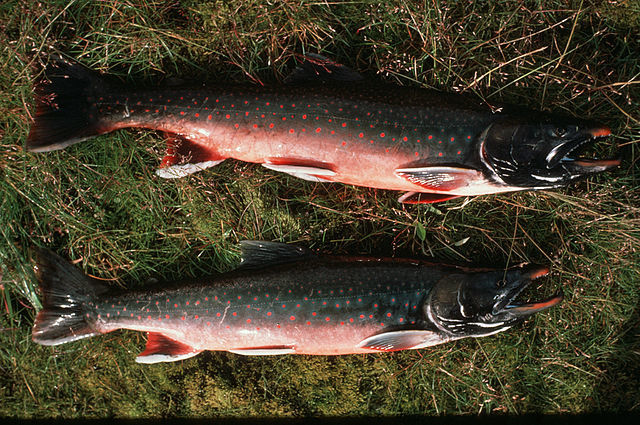
The Arctic char (Salvelinus alpinus) is a cold-water fish in the Salmonidae family that is endemic to alpine lakes and arctic and subarctic coastal seas. It is found in the circumpolar north.
It spawns in freshwater, and populations may be lacustrine, riverine, or anadromous, meaning they return from the ocean to spawn in the rivers where they were born.
No other freshwater fish species can be found thus far north; for example, it is the sole fish species in Lake Hazen on Ellesmere Island in the Canadian Arctic. It is one of the rarest fish species in the United Kingdom and Ireland, found mostly in deep, cold glacial lakes, and is threatened by acidification.
It is significantly more common and heavily fished in other regions of its range, such as the Nordic nations. It is known as golets (Russian: олe) in Siberia, and it has been introduced in lakes where it sometimes threatens less resilient native species, such as the small-mouth char and the long-finned char in Elgygytgyn Lake.
The Arctic char is related to both salmon and lake trout and has many traits with both. The color of the fish varies greatly depending on the time of year and the natural conditions of the lake where it dwells.
The look of Arctic char varies depending on population. The dorsal side of the Arctic char is black, while the ventral side is a mix of red, yellow, and white.
